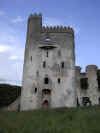

Click On Images to Enlarge
Castlecomer Plateau
The Castlecomer Plateau stretches for more than 200sq miles between the
Barrow & Nore river valleys. The Plateau developed approximately 35
million years ago during the Carboniferous period and because of the carboniferous
limestone, shale and coalmeasures resistance to weathering the Plateau
rises abruptly to over 1000ft
River Barrow
The River Barrow rises in the Slieve Bloom Mountains in the northwestern
side of Co. Laois. It is the second longest river in Ireland (192km).
It forms considerable parts of the county boundaries for Laois, Kildare,
Kilkenny & Carlow. The Rivers Barrow, Suir & the Nore form what
is known as the three sister rivers. The Barrow is well known for salmon
& trout fishing. The Slieve Margy Way follows the Barrow Way from
Clogrennan to Maganey. The Barrow Way is approved by the National Waymarked
Ways Committee. The River Barrow is maintained by Waterways Ireland. The
Barrow track is the old towpath for the Barrow Navigation.
Leinster Coalfields
The Swan/ Wolfhill/ Crettyard/ Newtown & Rossmore areas form the northern
part of the Castlecomer Plateau, the centre of the iron & coal mining
industry during the 18th & 19th centuries. The early mining methods
were labour intensive but highly profitable. The pits were continuously
pumped to avoid flooding. The main Pits in the area were located at Modubeagh,
Hollypark, Mullaghmore & Meeragh with Rossmore further south. In 1814
70,000 tons of coal were mined in the Leinster Coalfields at £1.00
per ton. In 1845 the output from the Laois Mines was valued at £78,000
with over 700 men employed. The working conditions were appalling with
many miners dying from consumption of the lungs by the age of 50. The
remains of the mines still leave their mark on the Slieve Margy Landscape.
The Graces of Gracefield
This Anglo - Norman family came to Ireland in 1170AD with Strongbow, the
Earl of Pembroke and they helped to shape the human landscape of the Slieve
Margy. The Graces amassed vast possessions in Leinster & Munster but
much of these lands were confiscated in the 1550s by Oliver Cromwell,
the Lord Protector.
The Graces lived at Shanganal, now known as Gracefield near Ballylynan.
The present house was built in 1818. Architect John Nash designed the
house, while 17 acres of terraced gardens were developed by landscaper
John Sutherland.
In Arles, the present Church of the Sacred Heart (1866) & its forerunner
(1686) were built under the patronage of the Grace Family. The famous
architect Pugin designed the church. Located in the grounds of the Church
is a well known landmark, the Grace Mausoleum.
William Russell Grace brought the Grace name to international prominence
when in 1854 he founded W.R Grace & Company. He was born in Gracefield
in 1832 and while in Peru he began to develop merchant steam shipping
linkages between Europe and the Americas. He became known as the Pirate
of Peru because he had such wealth and power he was able to mortgage the
entire country. He became the first Catholic Mayor of New York and in
1885 he accepted the Statute of Liberty on behalf of the American people
from France.
Oisin Park & House
A Dancing Board & House Dancing tradition in the Rossmore/ Killeshin
area dates back some considerable time. Up until the advent of World War
1 the tradition was strong. In 1927 the coal miners organised dances at
the crossroads and the tradition is still carried on here every Sunday
afternoon during the summer. This Park is operated by Rossmore Killeshin
Development Association and in 1999 they opened a rural conference centre.
This park is situated at over 1000ft above sea level and it offers panoramic
views of the Barrow Valley below which are bordered magnificently by the
Wicklow & Blackstairs Mountains. In the far distance the Dublin Mountains
are visible. The night time view of Carlow Town is impressive.
Culm Crusher/ Grinding Stone
The fine material from anthracite was called culm. To burn culm in domestic
fires it was crushed with yellow clay under the weight of a large edge-runner
grinding stone which was usually drawn by a horse. Mixed together with
water to form a bomb (pronounced bum) they were then burned on the open
fire.
Killeshin Romanesque Doorway
Early in the 6th century St Diarmuid founded a monastery at Killeshin.
No doorway of the Hiberno Romanesque period is more attractive in design
or epitomises so well native creativity than that of the ruined church
at Killeshin. The magnificent doorway may be attributed to the patronage
of Diarmuid Mac Murrough, the 12th century High King of Leinster.
Shrule Castle
The castle was built during the reign of Queen Elizabeth (1558 - 1603)
by Robert Hartpole, Constable of Carlow Castle & the Governer of Queens
County.
Ballyadams Castle
The following diary entry was made by Austin Cooper in 1782:
"At Ballyadams is a large Castle, the front consists of two large
round towers, between which is an entrance and over it a wall is carried
in a line with the exterior limits of these towers, so as to form a machicolation
over the door. Adjoining these towers on each side are two large modern
wings, one of which is kept in repair as a lodge by Mr Butler, the present
proprietor, the other never was finished. The inside of the castle exhibits
a scene sufficient to excite compassion from every lover of ancient grandeur
- the boarded floors all torn up, the plastered wall and ceilings threatening
the observer with destruction and to complete this grand scene of desolation,
the great state room still remains hung with elegant tapestrys now left
to rot away."
St Abbans Well
1798 Rising
In the late 18th century radical political policies which shaped the French
& American Revolutions began to influence some Irish politicians.
In 1791 the society of the United Irishmen was formed to look for political
changes for Ireland. When these tactics failed the society became a secret
society and it turned to violence to achieve its aims.
During the summer of 1798 many parts of the country were engulfed in revolution.
There were several incidents in the Slieve Margy Area, the most famous
was led by the Fr. Murphy of Wexford. On 24th June 1798 Fr Murphy had
led a large group of rebels out of Wexford where they had several victories
over the Crown forces. They marched to Doonane where the miners joined
them and they marched on Castlecomer. They succeeded in taking Castlecomer
but they returned to Laois and camped at Slatt Lower, beside Wolfhill.
They buried their dead in Wolfhill cemetery. The Crown forces began to
surround them and they headed for Wexford. Fr. Murphy became separated
from the main column and in Tullow, Co. Carlow he was hung by the Crown
Forces on July 2nd 1798.

